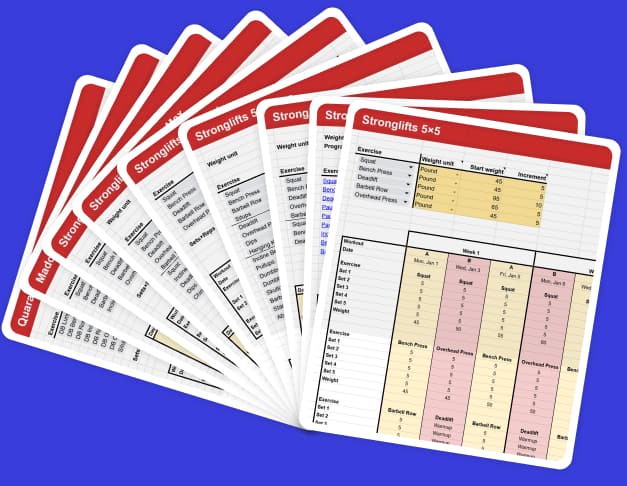Assistance work is adding exercises to Madcow 5×5 in order to…
- Work smaller muscles like the biceps and triceps
- Add volume for the Bench Press or Deadlift
Here’s how to add accessory work to Madcow 5×5.
Contents
Join the Stronglifts community to get free access to all the spreadsheets for every Stronglifts program. You’ll also get daily email tips to stay motivated. Enter your email below to sign up today for free.
Assistance work is optional
Do you need to do assistance work to get results on Madcow 5×5? No. As the name implies, assistance work is just assistance. It’s the cherry on the cake. Most of your strength and muscle gains will come from doing the main lifts – the Squat, Bench, Deadlift and Barbell Row.
Accessory work can help you get a little bit better results. But this has a cost: adding two exercises easily takes an extra 15min per workout.
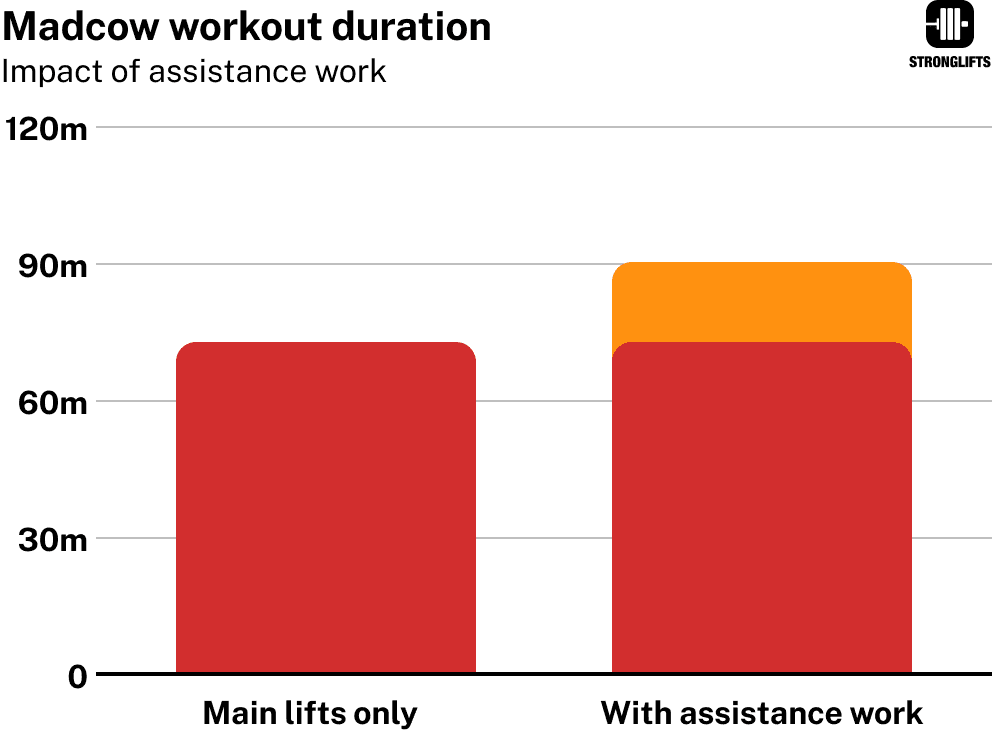
If you add two assistance exercises to each Madcow 5×5 workout, your gym time increases by 45min per week. Over three months, that’s an extra nine hours spent in the gym just for assistance work.
Many people don’t have that much time to exercise (1, 2, 3). Or they have better things to do than focusing on small muscles. If you lack time, it’s fine to skip the assistance work. It’s not essential to get results.
Madcow 5×5’s original assistance work
Let’s start with the original assistance work that Madcow suggested to add to each Madcow 5×5 workout.
| Workout A | Workout B | Workout C |
|---|---|---|
| Squat 5×5 | Squat 4×5 | Squat 4×5, 1×3, 1×8 |
| Bench 5×5 | Incline Bench 4×5 | Bench 4×5, 1×3, 1×8 |
| Rows 5×5 | Deadlift 4×5 | Rows 4×5, 1×3, 1×8 |
| Hyper-extension 2×8 | Situp 3×8 | Dips 3×8 |
| Situp 4×8 | Biceps curl 3×8 | |
| Triceps extension 3×8 |
Here’s what that means:
- Workout A has hyper-extensions for the lower back and situps for the abs. Both should be done weighted (if you can).
- Workout B has situps for abs. No hyper-extensions because you already have Deadlifts working your lower back.
- Workout C has three extra exercises for arms – dips and triceps extensions for triceps, and barbell curls for biceps.
You can enable this assistance work in the Stronglifts app by going to program – Madcow 5×5. Pick one of the options. We’ll add the exercises, sets and reps to each workout.
This assistance work is just an example. Madcow 5×5 was inspired by Chris Manrodt’s program created by Bill Starr. Chris wrote that different people did different types of accessory work (4). Quote…
The dips, bi’s and tri’s are what Bill called “Beach Work”…. The scheme for these varied by need and based on what I thought my weaknesses were. I went very heavy on the dips, for sets of 5, to help build up my triceps. Other guys did closegrips, or even added in some rowing movements for the lats.
– Chris Manrodt
That means you can do other exercises instead. You don’t have to do hyper-extensions if you don’t like it or lack the equipment for it.
Many Stronglifters add pullups and/or planks to Stronglifts 5×5. They don’t like to lose these exercises when switching to Madcow 5×5.
Here’s a Madcow 5×5 assistance work version that I’ve created. It adds exercises you might have done on Stronglifts 5×5.
| Workout A | Workout B | Workout C |
|---|---|---|
| Squat 5×5 | Squat 4×5 | Squat 4×5, 1×3, 1×8 |
| Bench 5×5 | Incline Bench 4×5 | Bench 4×5, 1×3, 1×8 |
| Rows 5×5 | Deadlift 4×5 | Rows 4×5, 1×3, 1×8 |
| Dips 3×8 | Pullups 3×8 | Barbell Curl 3×8 |
| Hanging Knee Raises 3×8 | Planks 3×30sec | Skullcrushers 3×8 |
Here’s how it works:
- Workout A has dips for chest, triceps, and hanging knee raises for abs.
- Workout B has pullups for biceps and back, and planks for abs.
- Workout C has curls for biceps, and skullcrushers for triceps.
This accessory work will take an extra 15min per workout. 3×30 sec to do each set + 2-3min rest between sets == ~7min/exercise.
Why 8? You’re already doing heavy sets of five on the main lifts. This works your arm muscles under tension. Doing higher reps on the assistance work trains your arm under fatigue. You get more pumped. Some guys need that to feel their workout was productive.
Doing higher reps also means you don’t have to go heavy again at the end of your workout where you’re already tired. The drawback is that 8 reps is harder on pullups and dips. Just do as many as you can.
If you don’t like barbell curls but prefer dumbbell curls, do that. If you don’t like situps but prefer hanging leg raises, do that. If you don’t like skullcrushers but prefer triceps pushdowns, do that. You can add what you want. But limit yourself to one or two extra lifts per workout.
If you can do three assistance exercises or more, you need to increase the weight on the main lifts. You’ll get tired more and won’t have the energy to do that much assistance work.
You can enable this assistance work in the Stronglifts app by going to program – Madcow 5×5 – pick one of the options. We’ll add the exercises, sets and reps to each workout.
Assistance work for Bench Press
The Bench Press works smaller muscles than the Squat and Deadlift. You’ll lift less and progress slower on the Bench. If you’re struggling to add weight, make sure you’re microloading and didn’t start too heavy. If this doesn’t help you can try adding assistance work for Bench.
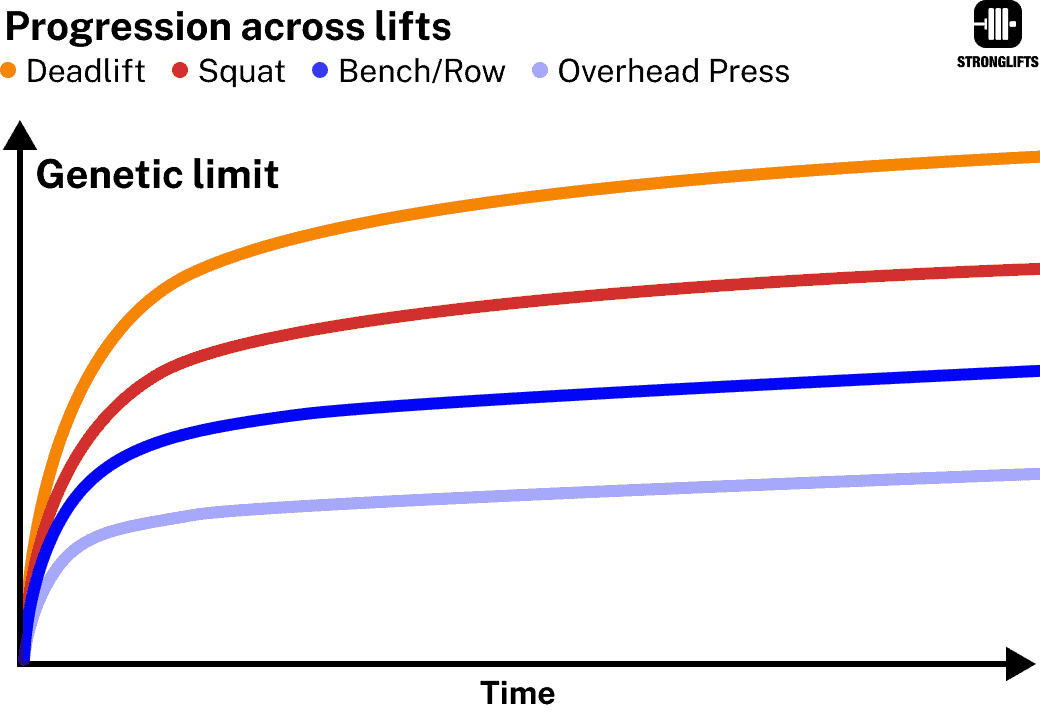
From my training and coaching experience, Bench can handle the same volume as Squats and Deadlifts. Madcow 5×5 has 11 sets per week for Rows, 15 for Bench and 19 sets for SQ+DL. You could add a few sets for Bench. This maximizes strength gains but don’t expect miracles. Doing 25% more sets doesn’t mean 25% more gains.
Some people can’t handle this much Bench work. My shoulders are fine Benching 4x/week but this wasn’t always the case. It took a while to get used to this. Some people get achy shoulders or elbows if they bench a lot. Others find that they need regular Overhead Pressing to keep their shoulders healthy (I do). People are different. There’s not one way.
That’s why I don’t like generalizing high volume benching for everyone. I prefer to start lower volume and add more slowly as needed. We do the same with the weight: start light, add more over time. Lifting weights has a low risk of injury (5). But rapid increases in volume can increase it (6). I wouldn’t add more than 10% volume at a time (7).
If you’re zero risk tolerant, Overhead Press in workout B and skip the assistance. If you’re low risk tolerant, Bench 3x/week for a while then add one accessory exercise for bench. After a few weeks, add a second one. If you’re high risk tolerant, add two right away. Like this…
| Workout A | Workout B | Workout C |
|---|---|---|
| Squat 5×5 | Squat 4×5 | Squat 4×5, 1×3, 1×8 |
| Bench 5×5 | Incline Bench 4×5 | Bench 4×5, 1×3, 1×8 |
| Rows 5×5 | Deadlift 4×5 | Rows 4×5, 1×3, 1×8 |
| CGBP 3×8 | Chinups 3×8 | DB Bench 3×8 |
Close Grip Bench Press adds work for your chest and triceps. Dumbbell Bench also adds work for your chest. These assistance exercises add volume to your Bench. You do five bench exercises per week. Chinups add work for your back and biceps.
If you prefer Floor Press or Dips, do that. If you want to replace one assistance exercise by Overhead Press to keep your shoulders happy, do that. Accessory work should be individualized to your needs. I’m giving you examples in case you don’t know what to do.
Why 3×8 and not 3×12? This assistance work is for getting stronger at Bench. A hard set of eight reps is about 78% of your max. A hard set of twelve reps is about 68% of your max. You can lift ~10% heavier when doing eight reps. Lifting heavy is important if you want to get better at lifting heavy.
Why not do five reps then? You’d lift even heavier, no? Yes, but you’re already doing that on the Bench. It’d be too tiring to do it again at the end of your workouts. Eight reps lighten the load a bit.
Adding Close Grip Bench Press and Dumbbell Bench for three sets each increases your Bench volume by 40% per week.
| Madcow 5×5 Chest volume | Bench, Incline Bench | Bench, DB Bench Incline Bench, CGBP |
|---|---|---|
| Workout A | 5 sets | 8 sets |
| Workout B | 4 sets | 4 sets |
| Workout C | 6 sets | 9 sets |
| Total/week | 15 sets | 21 sets (+40%) |
Squat + Deadlift was 19 sets per week. Why do 21 sets for Bench then? Why not do 19 sets? You could do 2×8 on the assistance exercises. But people usually think in one, three or five sets. We’re nitpicking.
When you include 11 sets per week for Barbell Rows, you end up with 65% work for your upper-body and 35% for your lower body.
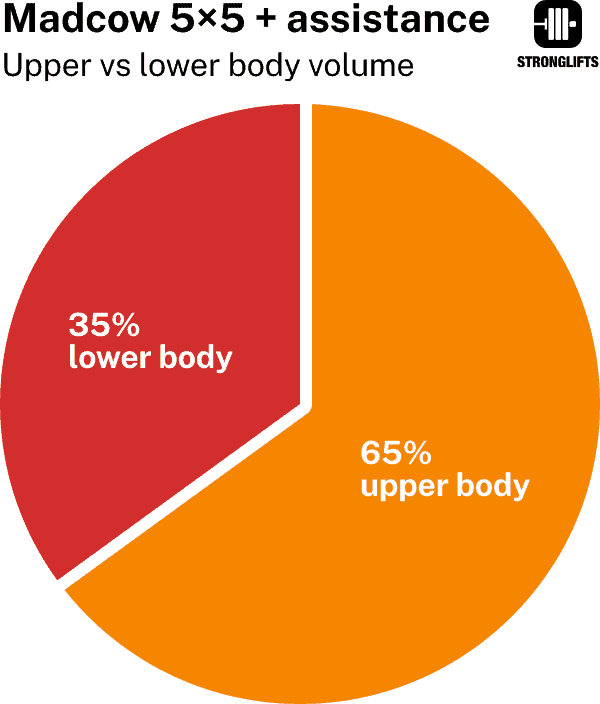
Assistance work for Deadlifts
Madcow 5×5 has enough Deadlifts to progress. I discussed this in detail here. Squatting 3x/week increases the Deadlift. Results of Stronglifters who have done Madcow 5×5 confirm this.
People who say Madcow 5×5 doesn’t have enough Deadlifts are either very advanced (I pull 508lb and usually Deadlift 2x/week). Or they aren’t adding enough weight on the bar and so the workouts are too easy. Or they’re doing pyramid sets by mistake which lowers the volume.
If you want more Deadlifts, add Romanian Deadlifts to Madcow 5×5. This exercise takes your knees out of the movement which forces you to use a lighter weight. You’ll alternate a heavy Deadlift session with a lighter RDL session. This is easier to manage for most people.
| Workout A | Workout B | Workout C |
|---|---|---|
| Squat 5×5 | Squat 4×5 | Squat 4×5, 1×3, 1×8 |
| Bench 5×5 | Incline Bench 4×5 | Bench 4×5, 1×3, 1×8 |
| Rows 5×5 | Deadlift 4×5 | Rows 4×5, 1×3, 1×8 |
| CGBP 3×8 | Chinups 3×8 | Romanian DL 3×8 |
Here’s how this works:
- Workout A has Close Grip Bench Press for chest and triceps. Workout B has chinups for biceps and back. If you don’t care about these exercises, drop them. I added them so you do four exercises in each workout.
- Workout C has RDL as a second and lighter Deadlift session.
Why RDL in workout C? You already Deadlift in workout B. If you work them heavy (which you should) you won’t have the energy to train RDL hard. Plus, workout B is supposed to be a light day.
Why not RDL in workout A? They can make your hamstrings really sore. You only have one rest day before Deadlifts in workout B. Soreness can hinder your progress. Putting RDL in workout C gives you two rest days before workout A. It also makes more sense to put RDL in workout C. That’s the heavy day with the highest volume.
Why 3×8? To limit how heavy you will go. You can train the Romanian Deadlift hard in workout C while keeping it a lighter session due to the higher rep range and the nature of the lift.
A minor optimization here would be to swap the RDL and Rows around in workout C. Like this…
| Workout A | Workout B | Workout C |
|---|---|---|
| Squat 5×5 | Squat 4×5 | Squat 4×5, 1×3, 1×8 |
| Bench 5×5 | Incline Bench 4×5 | Bench 4×5, 1×3, 1×8 |
| Rows 5×5 | Deadlift 4×5 | RDL 3×8 |
| CGBP 3×8 | Chinups 3×8 | Rows 4×5, 1×3, 1×8 |
You can lift heavier on Romanian Deadlifts than Barbell Rows. And you need your lower back for RDL. I would do RDL first and Barbell Rows next. This way you don’t tire your back for the Romanian Deadlift.
How much stronger do you get with assistance work?
Not much. Assistance work adds volume to your main lifts. The meta-analysis by Ralston et al found that high volume was “marginally more effective” (8). More is better but you get diminishing returns.

On Madcow 5×5 you Bench Press 15 sets per week. Say you add Close grip Bench and Dumbbell Bench for three sets each. You now do 21 sets per week for Bench. Your Bench volume is 40% higher than before.
Here’s what’s sure: doing 40% more sets will not increase your Bench Press by 40% more compared to doing 15 sets per week.
Most of the gains come from doing the first sets. Each additional set results in diminishing returns. The study by Ralston et al found that doing up to 5 sets per week per muscle resulted in about 80% of the strength gains (8). Doing +10 sets per week or double the volume resulted in 20% extra strength gains (and not 100% unlike what people think).
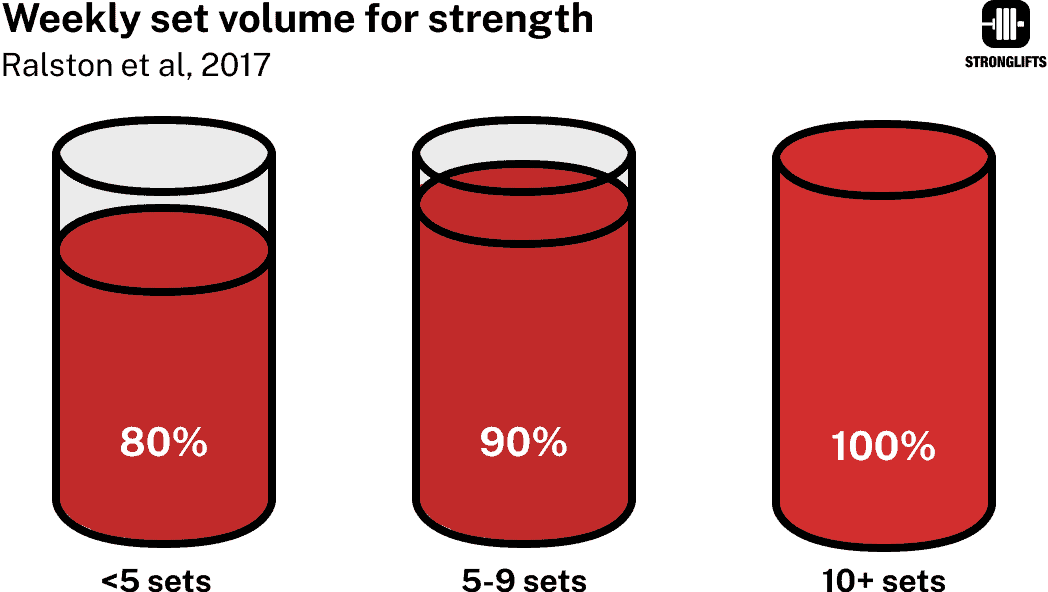
The more you do, the more you gain. But the extra gains are smaller and smaller the more you do. This is the law of diminishing returns.
If more is better then let’s do max volume, right? Not so fast. Too much volume can hinder strength gains by delaying recovery (9). If accessory work creates too much fatigue, that can hurt your progress.
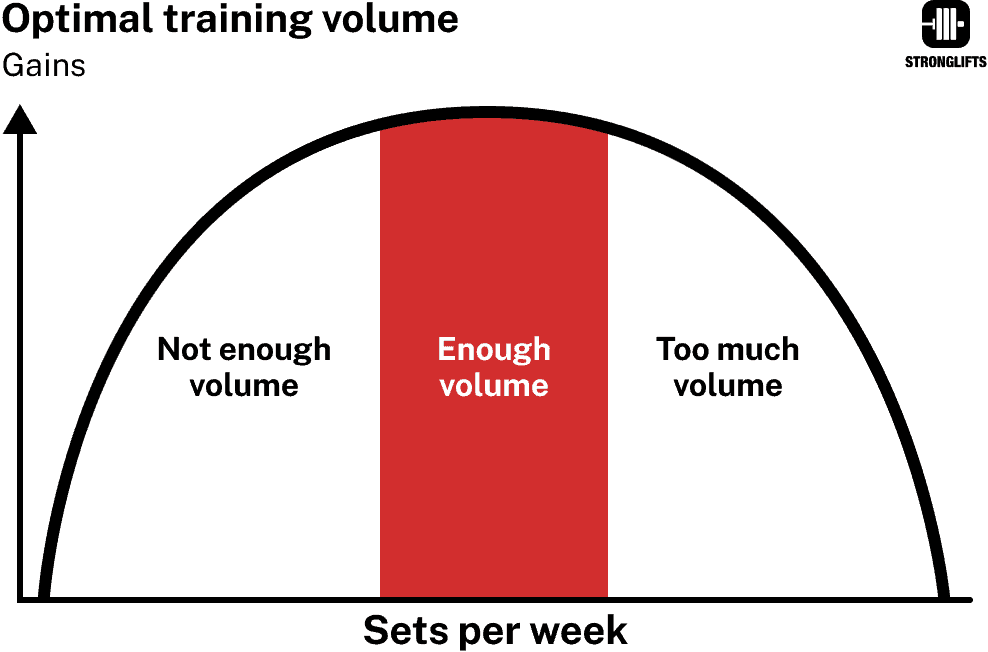
This is a common mistake on Madcow 5×5. The program starts light to ease you into the program. There’s a four week on-ramp. Some people think the volume is too little and so they add assistance work.
But the weights increase every week. This increases the volume over time. By week four or five the workouts are a lot more challenging. The extra accessory work is now too much. They have to drop it.
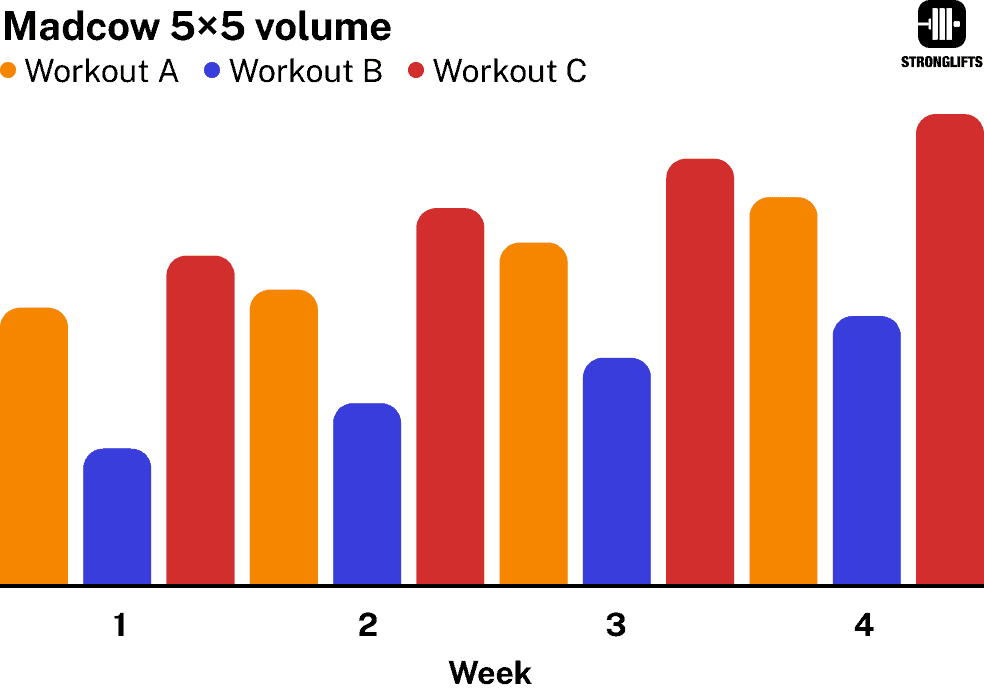
You also need to consider longevity. Adding a lot of volume can work in the short-term. But adding too much suddenly can result in aches and pains. These can take months to heal. You can’t train hard if you get hurt. You can’t get strong if you can’t train hard.
If you’re no longer making progress with your previous volume, you’re probably not a beginner anymore. The easy gains are over and so it only gets harder to get stronger from here on. Diminishing returns.
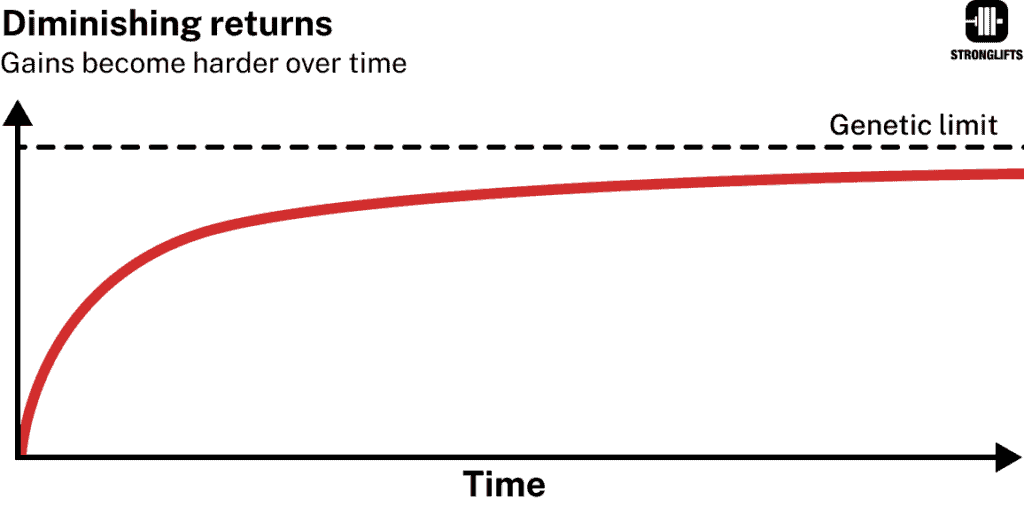
That means patience is needed past the easy beginner gains. It takes most people years to achieve a big Squat, Bench and Deadlift. You can’t just throw a ton of volume at your body to force it to grow. Your body will get stronger at the rate that it can get stronger. Doing too much too soon is a common way to get hurt and that will slow you down. Getting stronger is a marathon not a sprint.
How much bigger will my arms get with assistance work?
Not that much. Most of your gains will come from doing the main lifts. Barbell Rows work your biceps. Bench works your triceps.
Several studies have compared doing compounds only vs compounds plus isolation (10, 11, 12, 13). Every study shows that your arms get bigger when you do compound exercises. They don’t stay small.
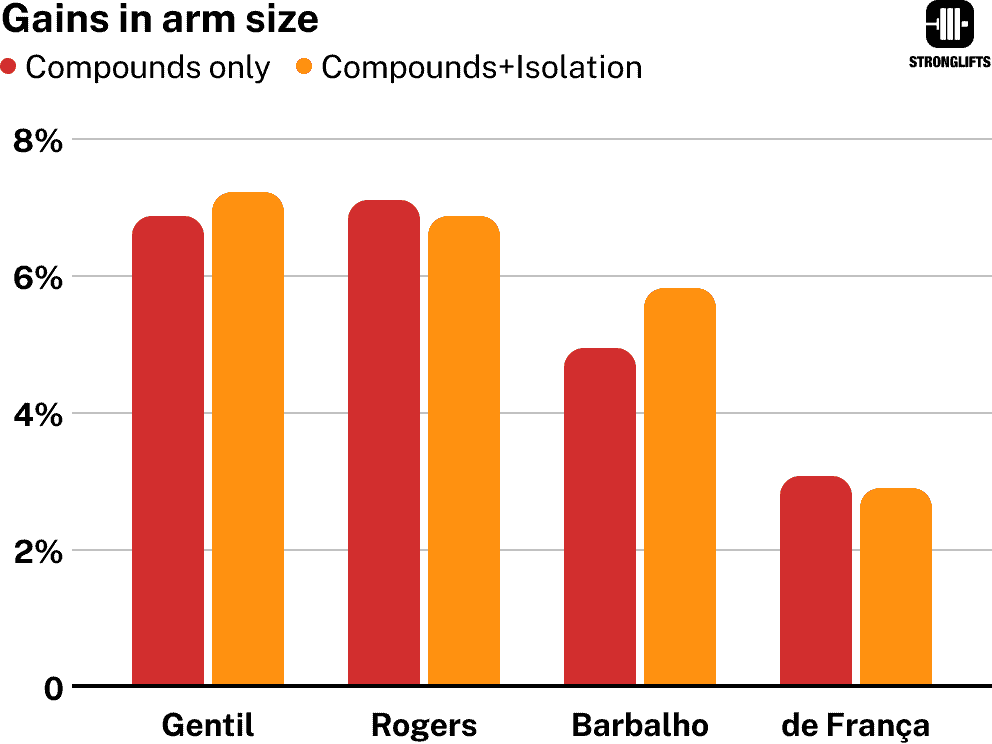
In the studies by Gentil, Rogers and de França the groups doing only compounds increased their arm size just as much as the groups doing extra isolation (10, 12, 13). Adding isolation had no benefit despite working biceps directly and adding volume. It only increased gym time by about 15min per workout according to de França.
In the Barbalho study, adding two isolation exercises like curls 2x/week increased arm size by an extra 0.4cm in 8 weeks (11). Assistance work usually takes 7min per exercise. Let’s do the math: 2 exercises 2x/week for 7min each is 30min/week or 2h/month extra gym time.
Is 0.16″ extra arm size worth training 2h/month more? Who will notice this? Are you an elite bodybuilder for whom a fifth of an inch can be the difference between placing on the podium or not. Most people don’t have time to exercise (1, 2, 3). They’re happy to train two hours less per month if that means only losing an extra 0.16″ in arm size.
The usual counter is that small gains add up over time. This is incorrect. Building muscle is not like saving money where the more you have the more you get through compound interest or so. Muscle gains follow an exponential decay rate (14). The more muscle you have, the harder to gain more muscle. Otherwise we’d all look like Ronnie Coleman.
Drug-free lifters gain about 2lb of lean muscle per month during their first year doing a proper training program like Stronglifts 5×5 (15). After that you gain less and less muscle each year.
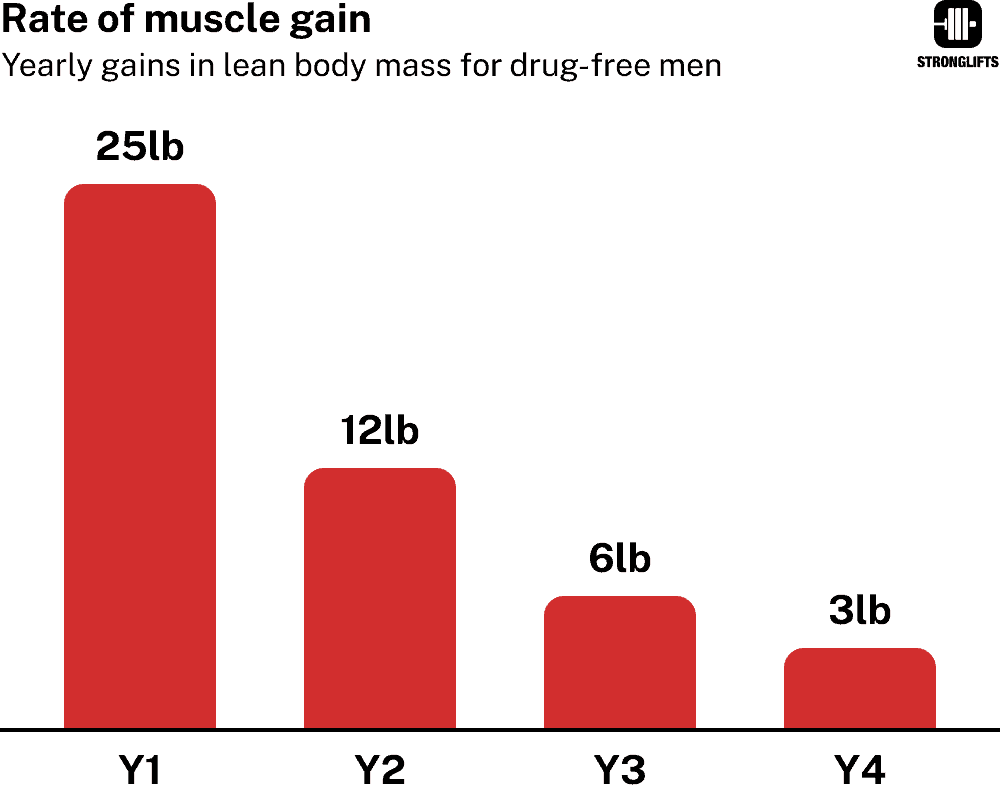
You can not gain an infinite amount of muscle (16). In the study by de França (13), the participants weren’t new lifters like in the other studies. They were trained lifters with two years of experience and 38cm/15″ arms. Their arms grew less because they were already bigger.
Maybe your arms grow a little bit faster if you do more work for them. But that usually just means plateauing faster. If you didn’t do more you’d get the same gains eventually anyway. More is better and necessary for elite bodybuilders looking to maximize gains to win competitions. But that’s not the goal or priority of the majority of lifters.
Two more studies have compared isolation vs compounds for bigger arms. They’re not that ecologically valid since lifters usually don’t do one or the other. They usually do isolation for arms on top of doing compounds. I’m including them anyway for completeness.
- Gentil et al had one group do legs, bench, lat pulldowns, the other did legs, bench, curls (17). Gains in arm size were the same.
- In contrast, Mannarino et al found that arm size increased by 11.2% with dumbbell curls vs 5.8% with dumbbell rows (18).
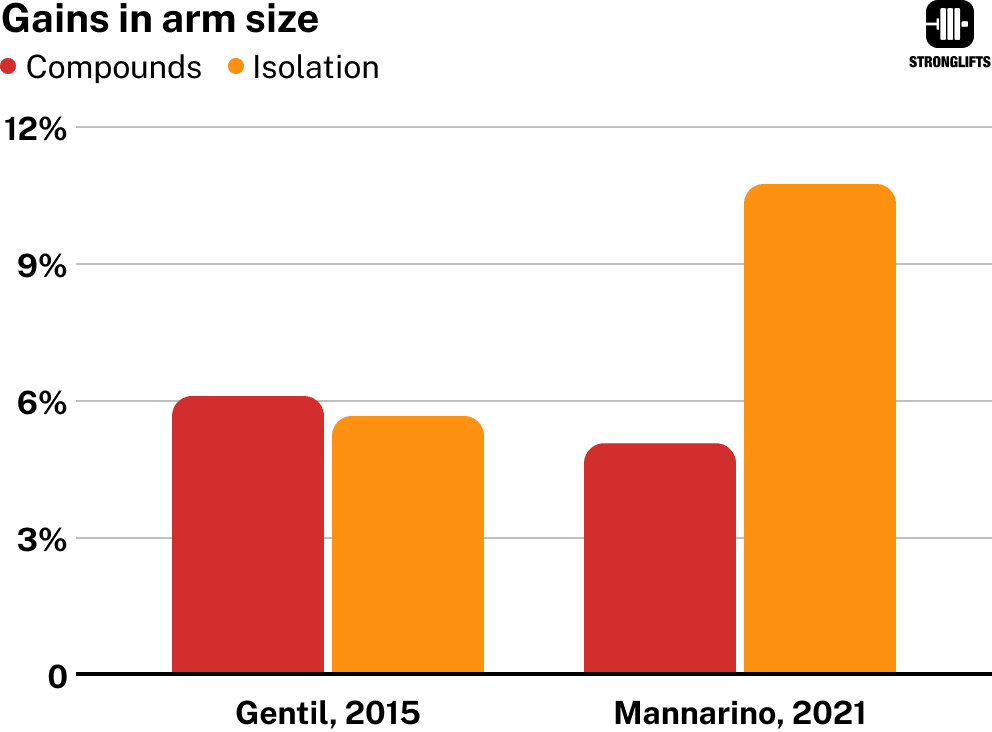
Here’s the difference:
Gentil measured the biceps at one site using ultrasound (the machine used for pregnancy scans). Mannarino measured three sites. They were better able to catch subtle changes in hypertrophy. What you should care about is if anyone outside the lab will notice these same subtle changes with their naked eyes. Why do you think they needed to use ultrasounds instead of simple tape measurements?
Mannarino’s results were “statistically significant”. But they didn’t share the size of the arms before and after. All we know is that DB curl was 11% vs 6% for DB row. Some people then go “DB curl resulted in twice the gains!” Yes, but what was the size of the gains? Say your friend brags about doubling his money buying some crypto scam. You ask for details. He then explains he bought coins for $5 and they’re now worth $10. Okay, he DID double his money. But it’s $5. Who cares? Just because the results of a study are “statistically significant” doesn’t mean they’re important for you.
Here are some counter-points for balance:
- Beginners can build muscle faster with isolation. There’s little technique to learn (19). You can load the muscle heavy more quickly. But the gains with compouns catch up over time. And Madcow 5×5 isn’t for beginners. Stronglifts 5×5 is.
- Different muscles probably respond differently. Most people add curls and that doesn’t seem to make much difference. It looks like isolation makes more of a difference for triceps (20). But again, it’s not like your arm will suddenly grow twice in size.
- Some guys feel more confident doing curls. In my early 20s, we trained chest every Saturday evening before going to clubs to meet girls. Our goal was to get our chest pumped to the max. Silly looking back – as soon as you leave the gym the pump is gone. But the placebo effect can be strong.
If you like curls, if you think it makes a difference or if it makes you feel more confident, do it. If you’re younger, don’t have a full time job with a family but a lot of free time – do it. Several people I coach do curls. But they train the main lifts hard. They know assistance is assistance. They don’t skip Squats to do five different curl exercises.
One last thing. If you’re skinny, don’t expect to build bigger arms without getting your body bigger first. Achieving 16” arms at 135lb body weight is impossible unless you inject synthol (21).
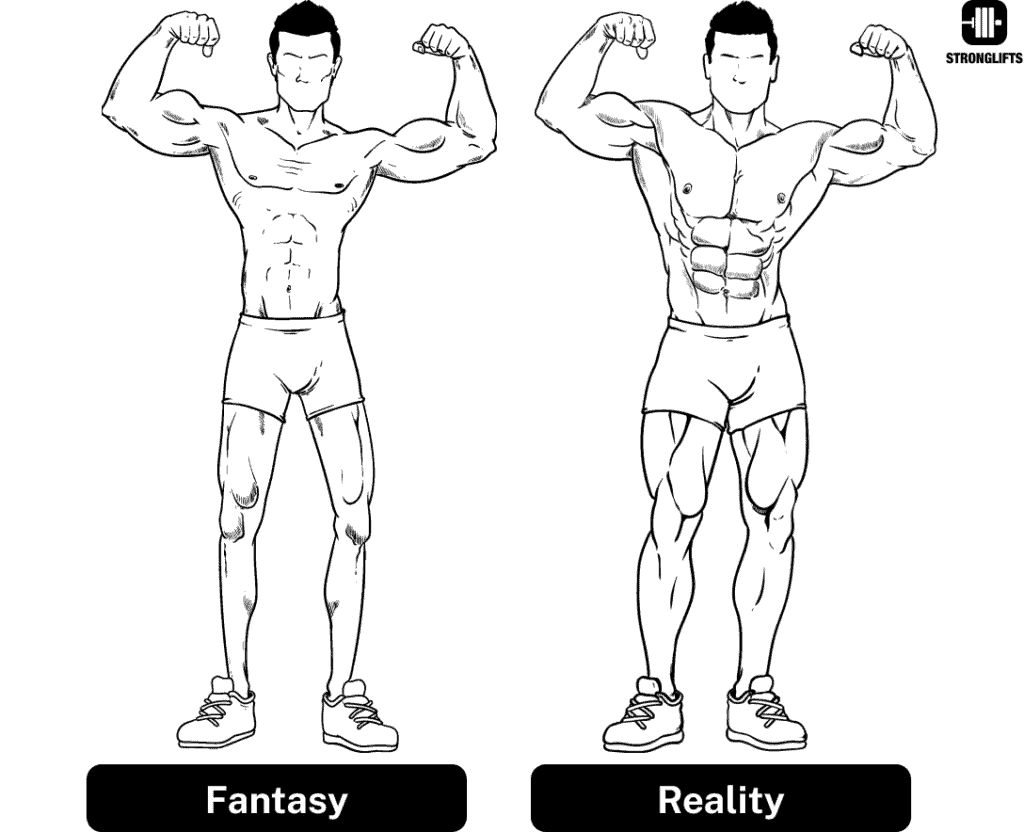
The rule of thumb is that you need to gain about 10lb of body weight for every inch you want to add to your arms (22). That means that the best way to get bigger arms is often not more curls. It’s more “forklifts” – lifting more food into your mouth with your fork so you gain weight.
Join the Stronglifts community to get free access to all the spreadsheets for every Stronglifts program. You’ll also get daily email tips to stay motivated. Enter your email below to sign up today for free.
References
1. Booth, M L et al. “Physical activity preferences, preferred sources of assistance, and perceived barriers to increased activity among physically inactive Australians.” Preventive medicine vol. 26,1 (1997): 131-7.
2. Trost, Stewart G et al. “Correlates of adults’ participation in physical activity: review and update.” Medicine and science in sports and exercise vol. 34,12 (2002): 1996-2001.
3. Silliman, K., K. Rodas-Fortier, and M. Neyman. “Survey of Dietary and Exercise Habits and Perceived Barriers to Following a Healthy Lifestyle in a College Population”. Californian Journal of Health Promotion, Vol. 2, no. 2, June 2004, pp. 10-19.
4. Manrodt, Chris. “New Lifter.” Strength Online, http://www.deepsquatter.com/strength/archives/manrodt4.htm.
5. Keogh, Justin W L, and Paul W Winwood. “The Epidemiology of Injuries Across the Weight-Training Sports.” Sports medicine (Auckland, N.Z.) vol. 47,3 (2017): 479-501.
6. Bourdon, Pitre C et al. “Monitoring Athlete Training Loads: Consensus Statement.” International journal of sports physiology and performance vol. 12,Suppl 2 (2017): S2161-S2170.
7. Gabbett, Tim J et al. “High training workloads alone do not cause sports injuries: how you get there is the real issue.” British journal of sports medicine vol. 50,8 (2016): 444-5.
8. Ralston, Grant W et al. “The Effect of Weekly Set Volume on Strength Gain: A Meta-Analysis.” Sports medicine (Auckland, N.Z.) vol. 47,12 (2017): 2585-2601.
9. Schoenfeld, Brad J et al. “Resistance Training Volume Enhances Muscle Hypertrophy but Not Strength in Trained Men.” Medicine and science in sports and exercise vol. 51,1 (2019): 94-103.
10. Gentil, Paulo et al. “Effect of adding single-joint exercises to a multi-joint exercise resistance-training program on strength and hypertrophy in untrained subjects.” Applied physiology, nutrition, and metabolism = Physiologie appliquee, nutrition et metabolisme vol. 38,3 (2013): 341-4.
11. Barbalho, Matheus et al. “Does the addition of single joint exercises to a resistance training program improve changes in performance and anthropometric measures in untrained men?.” European journal of translational myology vol. 28,4 7827. 2 Nov. 2018.
12. Rogers, R. A., et al. “The effect of supplemental isolated weight- training exercises on upper-arm size and upper-body strength.” NSCA Conference. 2000. https://paulogentil.com/pdf/The effect of supplemental isolated weight training exercises on upper arm size and upper body strength.pdf
13. de França, Henrique Silvestre et al. “The effects of adding single-joint exercises to a multi-joint exercise resistance training program on upper body muscle strength and size in trained men.” Applied physiology, nutrition, and metabolism = Physiologie appliquee, nutrition et metabolisme vol. 40,8 (2015): 822-6.
14. Butt, Casey. “Rate of Drug-Free Muscle Gain.” The WeighTrainer, https://web.archive.org/web/20210513174748/weightrainer.net/rate_of_gain.html.
15. McDonald, Lyle. “What’s My Genetic Muscular Potential?” Bodyrecomposition, 7 June 2020, https://bodyrecomposition.com/ muscle-gain/genetic-muscular-potential.
16. Counts, Brittany R et al. “Muscle growth: To infinity and beyond?.” Muscle & nerve vol. 56,6 (2017): 1022-1030.
17. Gentil, Paulo et al. “Single vs. Multi-Joint Resistance Exercises: Effects on Muscle Strength and Hypertrophy.” Asian journal of sports medicine vol. 6,2 (2015): e24057.
18. Mannarino, Pietro et al. “Single-Joint Exercise Results in Higher Hypertrophy of Elbow Flexors Than Multijoint Exercise.” Journal of strength and conditioning research vol. 35,10 (2021): 2677-2681.
19. Chilibeck, P D et al. “A comparison of strength and muscle mass increases during resistance training in young women.” European journal of applied physiology and occupational physiology vol. 77,1-2 (1998): 170-5.
20. Brandão, Lucas et al. “Varying the Order of Combinations of Single- and Multi-Joint Exercises Differentially Affects Resistance Training Adaptations.” Journal of strength and conditioning research vol. 34,5 (2020): 1254-1263.
21. Sisti, Andrea et al. “Oil injection for cosmetic enhancement of the upper extremities: a case report and review of literature.” Acta bio-medica : Atenei Parmensis vol. 91,3 e2020082. 7 Sep. 2020
22. Butt, Casey. Your muscular potential: how to predict your maximum muscular bodyweight and measurements. 4th ed, Myogenic Enterprises, 2009. https://web.archive.org/web/20210813110855/www.weightrainer.net/potential_e-book.html.




